| The
residents of Spanish America were divided by, and
at times fascinated by, ethnicity. While people distinguished
and explained differences among themselves in a variety
of ways, they also relied upon visual culture to play
a role in defining—and often repressing—these
distinctions.
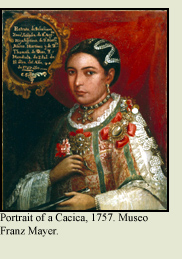 The
idea of “ethnicity” is, of course, of
recent coinage. In Spanish America, blood lineage
was one of the most important criteria for distinguishing
among people. Portraits of wealthy individuals—be
they Spaniards, Creoles or native elites—often
recorded genealogical information alongside the sitter’s
likeness. People in Spanish America also subscribed
to a hierarchical model of society, with different
castes ranked into an ordered system. Beyond this,
at least in theory, individuals were also divided
into two “republics,” one Spanish, the
other indigenous. In reality, however, social order
never adhered to such neat categories. The
idea of “ethnicity” is, of course, of
recent coinage. In Spanish America, blood lineage
was one of the most important criteria for distinguishing
among people. Portraits of wealthy individuals—be
they Spaniards, Creoles or native elites—often
recorded genealogical information alongside the sitter’s
likeness. People in Spanish America also subscribed
to a hierarchical model of society, with different
castes ranked into an ordered system. Beyond this,
at least in theory, individuals were also divided
into two “republics,” one Spanish, the
other indigenous. In reality, however, social order
never adhered to such neat categories.
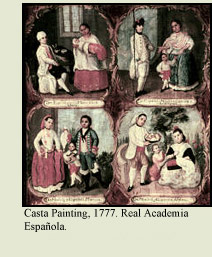 Within
nine months of the arrival of the conquistadors, the
first mestizo children were born—sons and daughters
of these foreigners and native women. In the decades
following, more and more mestizo children were produced
by marriages, informal liaisons, casual affairs, and
rapes. People with fully European ancestry would also
be born in the Americas (known as Creoles), as would
those of African and Asian descent. Yet in numbers,
if not wealth or status, native people and then mestizos
were dominant. The word, mestizo, commonly carried
negative connotations in colonial Spanish America.
In the 17th century, for instance, a Spanish dictionary
defined mestizo as a mix of different species of animals.
By implication, it was a trespass of the order of
nature: if Spaniards defined “pure” or
“noble” blood as good, then they considered
its dilution, or loss of purity via mixing, undesirable. Within
nine months of the arrival of the conquistadors, the
first mestizo children were born—sons and daughters
of these foreigners and native women. In the decades
following, more and more mestizo children were produced
by marriages, informal liaisons, casual affairs, and
rapes. People with fully European ancestry would also
be born in the Americas (known as Creoles), as would
those of African and Asian descent. Yet in numbers,
if not wealth or status, native people and then mestizos
were dominant. The word, mestizo, commonly carried
negative connotations in colonial Spanish America.
In the 17th century, for instance, a Spanish dictionary
defined mestizo as a mix of different species of animals.
By implication, it was a trespass of the order of
nature: if Spaniards defined “pure” or
“noble” blood as good, then they considered
its dilution, or loss of purity via mixing, undesirable.
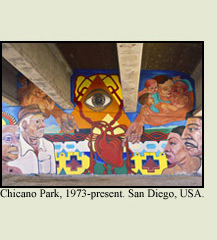 Yet
the meaning of mestizo has hardly remained stable
over time, as this 20th-century Chicano mural suggests.
Throughout the colonial period, the elites of Spanish
America, be they Spaniards or Creoles, called those
of Spanish/indigenous descent mestizos, and viewed
these people as members of society who, although filling
city streets and town squares, challenged ideal concepts
of the social order. By the 20th century, particularly
after the Mexican Revolution, mestizo came to carry
positive meanings—after all, the majority of
Latin American nations were peopled by mestizos. The
words mestizo and mestizaje share the same root, and
therefore a similar history, yet mestizaje is the
primary concern here. This is the larger phenomenon,
continuing today, of the great ethnic and cultural
amalgam created, not just by Spaniards and native
people, but by generations of immigration and social
interaction in Spanish America. Yet
the meaning of mestizo has hardly remained stable
over time, as this 20th-century Chicano mural suggests.
Throughout the colonial period, the elites of Spanish
America, be they Spaniards or Creoles, called those
of Spanish/indigenous descent mestizos, and viewed
these people as members of society who, although filling
city streets and town squares, challenged ideal concepts
of the social order. By the 20th century, particularly
after the Mexican Revolution, mestizo came to carry
positive meanings—after all, the majority of
Latin American nations were peopled by mestizos. The
words mestizo and mestizaje share the same root, and
therefore a similar history, yet mestizaje is the
primary concern here. This is the larger phenomenon,
continuing today, of the great ethnic and cultural
amalgam created, not just by Spaniards and native
people, but by generations of immigration and social
interaction in Spanish America.
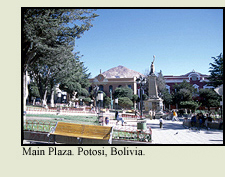 Consequently,
the mestizaje of the 21st century includes not only
people of European and indigenous descent, but also
those from Africa and their children born in the Americas.
Beginning in the 15th century Africans and African
Americans became integral members of Spanish American
society either as freemen or slaves. And by the 17th
century, they could be found in almost every region
in the colony. As the populations of cities burgeoned,
people of different ethnic origins came to live at
close quarters, and their interchanges, both sexual
and social, were creating a dynamic new society. Public
plazas, squares, parks and markets became sites for
all kinds of social and economic interaction. Consequently,
the mestizaje of the 21st century includes not only
people of European and indigenous descent, but also
those from Africa and their children born in the Americas.
Beginning in the 15th century Africans and African
Americans became integral members of Spanish American
society either as freemen or slaves. And by the 17th
century, they could be found in almost every region
in the colony. As the populations of cities burgeoned,
people of different ethnic origins came to live at
close quarters, and their interchanges, both sexual
and social, were creating a dynamic new society. Public
plazas, squares, parks and markets became sites for
all kinds of social and economic interaction.
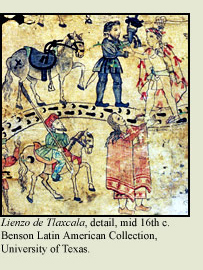 While
people in Spanish America would never have used the
term mestizaje to describe their own objects and buildings,
it provides an important interpretive framework to
foreground the potent and ongoing interchanges between
people of different ethnicities—which ranged
from the tumultuous to the unremarkable. Since a person’s
political and social power were enmeshed with his
or her ethnic identity, examining mestizaje also demands
an analysis of power relationships. In order to illuminate
how such interactions left their trace upon, or were
themselves shaped by visual culture, this section
emphasizes the role of ethnic difference in the production
and use of objects, images, and physical spaces. Images
that explicitly depict mixed populations, or the historical
figures who created the first mestizos of the Americas,
like Hernán Cortés and Doña Marina,
are important in the examination of mestizaje, but
such paintings and drawings are not the only sites
where visual culture conjoins with ethnic difference. While
people in Spanish America would never have used the
term mestizaje to describe their own objects and buildings,
it provides an important interpretive framework to
foreground the potent and ongoing interchanges between
people of different ethnicities—which ranged
from the tumultuous to the unremarkable. Since a person’s
political and social power were enmeshed with his
or her ethnic identity, examining mestizaje also demands
an analysis of power relationships. In order to illuminate
how such interactions left their trace upon, or were
themselves shaped by visual culture, this section
emphasizes the role of ethnic difference in the production
and use of objects, images, and physical spaces. Images
that explicitly depict mixed populations, or the historical
figures who created the first mestizos of the Americas,
like Hernán Cortés and Doña Marina,
are important in the examination of mestizaje, but
such paintings and drawings are not the only sites
where visual culture conjoins with ethnic difference.
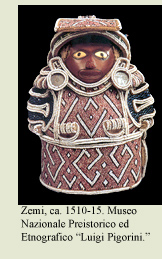 Indeed,
looking at visual culture through the framework of
mestizaje allows 21st-century viewers to see things
about Spanish America that were often implicit in,
or not commented upon by people of the past. This
Taíno zemi offers one example. The zemi’s
material composition—local Caribbean fiber,
Venetian glass, and African rhinoceros horn—could
only result from the interaction between traders from
Europe and Africa, Spanish conquistadors, and Taíno
inhabitants of the Caribbean. While it is unlikely
that the indigenous man or woman who crafted this
extraordinary work did so with “mestizaje”
on his or her mind, the experience of cultural interchange
among peoples of different ethnicities is nonetheless
embodied in this object. Today mestizaje is a frequent
focus of 21st-century histories of the colonial past.
For the connections among Africa, Europe and the Americas
which take material form in this beaded object are
the very connections that give the history of Latin
America its unique narratives. Indeed,
looking at visual culture through the framework of
mestizaje allows 21st-century viewers to see things
about Spanish America that were often implicit in,
or not commented upon by people of the past. This
Taíno zemi offers one example. The zemi’s
material composition—local Caribbean fiber,
Venetian glass, and African rhinoceros horn—could
only result from the interaction between traders from
Europe and Africa, Spanish conquistadors, and Taíno
inhabitants of the Caribbean. While it is unlikely
that the indigenous man or woman who crafted this
extraordinary work did so with “mestizaje”
on his or her mind, the experience of cultural interchange
among peoples of different ethnicities is nonetheless
embodied in this object. Today mestizaje is a frequent
focus of 21st-century histories of the colonial past.
For the connections among Africa, Europe and the Americas
which take material form in this beaded object are
the very connections that give the history of Latin
America its unique narratives.
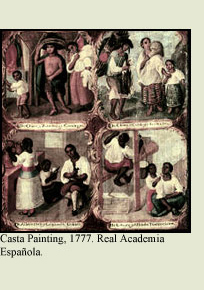 This
rift—in which people in the past dealt with
genealogical information and ethnic interaction in
ways quite distinct from today—is central to
Vistas. Certainly the significance and use
of objects in the past lent visual culture an important
set of meanings, but not the only set. Current narratives
and trends, like the development of ethnic studies
since the 1960s, shape the questions asked today.
So too do desires to understand historical practices
associated with the modern terms “race”
and “class.” For instance, casta paintings,
of which this image is a detail, comprise a whole
genre of 18th-century paintings describing the ethnic
admixtures in Spanish America. While casta paintings
have been the subject of several recent books and
exhibitions, they were almost invisible in art histories
of Spanish America written before 1960, and only a
little is known about what 18th-century viewers made
of them. As 21st-century interpreters, we are thus
bound to the colonial contexts of images and sites,
but we are also bound to present concerns. This tension
is part of the reckoning that this section seeks to
address. This
rift—in which people in the past dealt with
genealogical information and ethnic interaction in
ways quite distinct from today—is central to
Vistas. Certainly the significance and use
of objects in the past lent visual culture an important
set of meanings, but not the only set. Current narratives
and trends, like the development of ethnic studies
since the 1960s, shape the questions asked today.
So too do desires to understand historical practices
associated with the modern terms “race”
and “class.” For instance, casta paintings,
of which this image is a detail, comprise a whole
genre of 18th-century paintings describing the ethnic
admixtures in Spanish America. While casta paintings
have been the subject of several recent books and
exhibitions, they were almost invisible in art histories
of Spanish America written before 1960, and only a
little is known about what 18th-century viewers made
of them. As 21st-century interpreters, we are thus
bound to the colonial contexts of images and sites,
but we are also bound to present concerns. This tension
is part of the reckoning that this section seeks to
address.
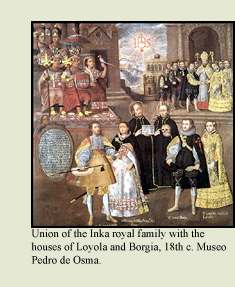 In
many instances, such reckoning yields rich results.
The concerns of past viewers about mestizaje are evident
in this painting from Cuzco, which portrays the 16th-century
marriage of an Inka princess, or ñusta, to
a Spanish conquistador, and the later wedding of their
mestiza daughter to another Spanish grandee. Notably,
the mestiza at the far right has lost the physical
markers of an indigenous identity. Her skin is pale,
her dress and posture European in style. Through its
visual language, the painting implies that the religious
ritual of marriage creates a mestizo lineage in which
assimilation is nearly seamless. This lesson might
have been instructive—or encouraging—for
the painting’s original patrons, but for 21st-century
viewers thinking about the power dynamics of mestizaje,
the scene raises other questions. For instance, what
political and physical powers were exerted to create
a society in which a marriage such as this one could
take place? And what does it mean when a painting
glosses over the daily experience of such power, power
which would have been keenly felt by the wedding participants? In
many instances, such reckoning yields rich results.
The concerns of past viewers about mestizaje are evident
in this painting from Cuzco, which portrays the 16th-century
marriage of an Inka princess, or ñusta, to
a Spanish conquistador, and the later wedding of their
mestiza daughter to another Spanish grandee. Notably,
the mestiza at the far right has lost the physical
markers of an indigenous identity. Her skin is pale,
her dress and posture European in style. Through its
visual language, the painting implies that the religious
ritual of marriage creates a mestizo lineage in which
assimilation is nearly seamless. This lesson might
have been instructive—or encouraging—for
the painting’s original patrons, but for 21st-century
viewers thinking about the power dynamics of mestizaje,
the scene raises other questions. For instance, what
political and physical powers were exerted to create
a society in which a marriage such as this one could
take place? And what does it mean when a painting
glosses over the daily experience of such power, power
which would have been keenly felt by the wedding participants?
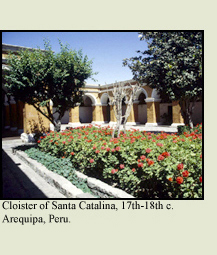 In
the realm of architecture, interaction among people
of different ethnicities was clearly marked in practices
that translated to physical or material terms. For
instance, convents are usually thought of as female
retreats devoted to enriching the spiritual lives
of their inhabitants, but they too were shaped by
ethnic hierarchies and exchanges. Many convents had
small cells for the mestiza and mulatta servants who
served the Creole nuns living in more spacious quarters.
Some convents were meant for only well-born mestizas,
but their relative lack of financial resources, and
therefore size and architectural importance, reinforced
the presence of ethnic hierarchies to all city dwellers.
In monasteries, the murals of the lower cloisters
were often aimed at the indigenous students who entered
there, while the murals of the upper floors were meant
for contemplation of European or Creole friars. In
the realm of architecture, interaction among people
of different ethnicities was clearly marked in practices
that translated to physical or material terms. For
instance, convents are usually thought of as female
retreats devoted to enriching the spiritual lives
of their inhabitants, but they too were shaped by
ethnic hierarchies and exchanges. Many convents had
small cells for the mestiza and mulatta servants who
served the Creole nuns living in more spacious quarters.
Some convents were meant for only well-born mestizas,
but their relative lack of financial resources, and
therefore size and architectural importance, reinforced
the presence of ethnic hierarchies to all city dwellers.
In monasteries, the murals of the lower cloisters
were often aimed at the indigenous students who entered
there, while the murals of the upper floors were meant
for contemplation of European or Creole friars.
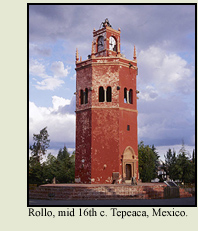 Architecture,
as well as other forms of visual culture, thus created
and reinforced ethnic distinctions. Reckoning with
mestizaje often means looking “below the surface”
or “beyond” the obvious physical features
of an object or site. This tower was raised nearly
five hundred years ago in a small Nahua community
in New Spain. The style of the Rollo, with ogee arches
and octagonal plan, harkens back to models of Islamic
architecture. Yet the tower came into being only through
extensive negotiations among peoples of different
ethnicities and the labor of native people who never
met an Islamic architect. Thus the lens of mestizaje
brings to this building an understanding of both the
visible and invisible aspects of ethnic interchange
in the colonial world. And in so doing demonstrates
how mestizaje’s relationship to visual culture
is a complex and revealing way to reckon with the
past. Architecture,
as well as other forms of visual culture, thus created
and reinforced ethnic distinctions. Reckoning with
mestizaje often means looking “below the surface”
or “beyond” the obvious physical features
of an object or site. This tower was raised nearly
five hundred years ago in a small Nahua community
in New Spain. The style of the Rollo, with ogee arches
and octagonal plan, harkens back to models of Islamic
architecture. Yet the tower came into being only through
extensive negotiations among peoples of different
ethnicities and the labor of native people who never
met an Islamic architect. Thus the lens of mestizaje
brings to this building an understanding of both the
visible and invisible aspects of ethnic interchange
in the colonial world. And in so doing demonstrates
how mestizaje’s relationship to visual culture
is a complex and revealing way to reckon with the
past.

|
